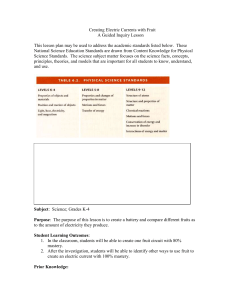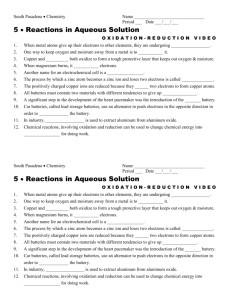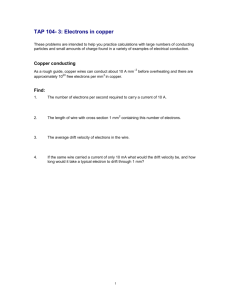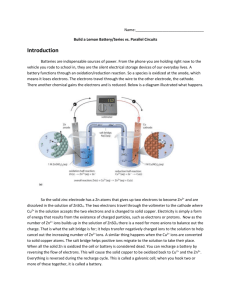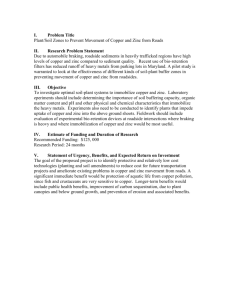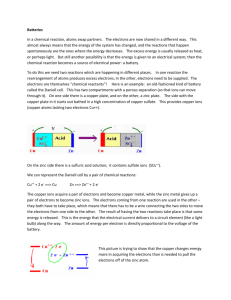Electric Lemons - Demonstration and Investigation
advertisement
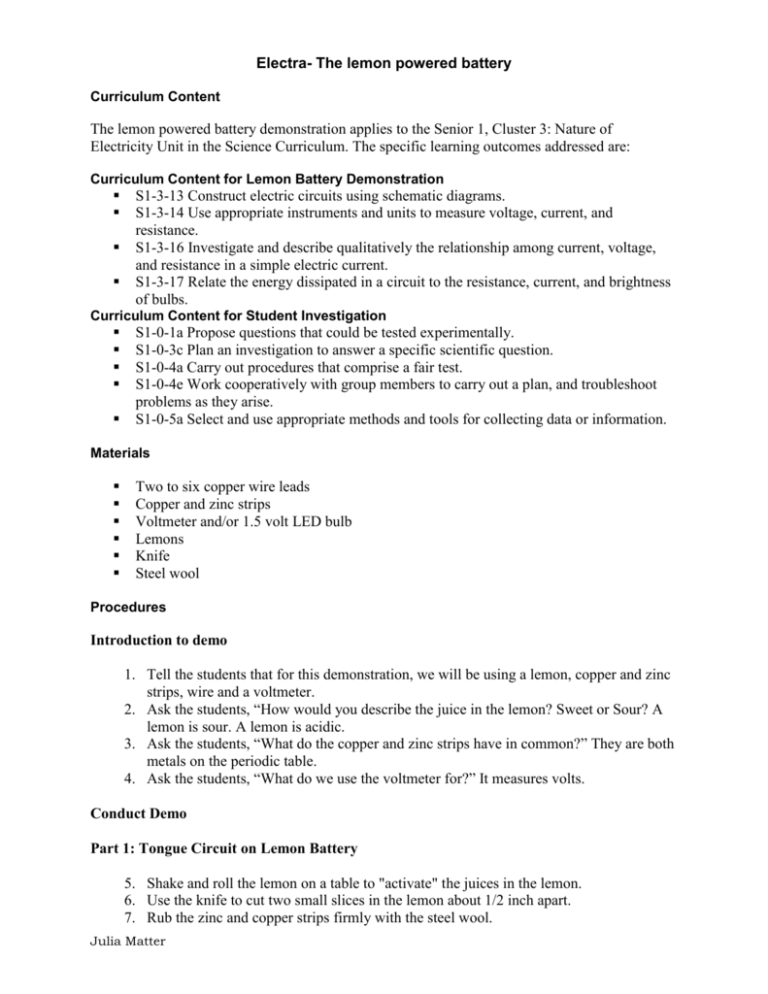
Electra- The lemon powered battery Curriculum Content The lemon powered battery demonstration applies to the Senior 1, Cluster 3: Nature of Electricity Unit in the Science Curriculum. The specific learning outcomes addressed are: Curriculum Content for Lemon Battery Demonstration S1-3-13 Construct electric circuits using schematic diagrams. S1-3-14 Use appropriate instruments and units to measure voltage, current, and resistance. S1-3-16 Investigate and describe qualitatively the relationship among current, voltage, and resistance in a simple electric current. S1-3-17 Relate the energy dissipated in a circuit to the resistance, current, and brightness of bulbs. Curriculum Content for Student Investigation S1-0-1a Propose questions that could be tested experimentally. S1-0-3c Plan an investigation to answer a specific scientific question. S1-0-4a Carry out procedures that comprise a fair test. S1-0-4e Work cooperatively with group members to carry out a plan, and troubleshoot problems as they arise. S1-0-5a Select and use appropriate methods and tools for collecting data or information. Materials Two to six copper wire leads Copper and zinc strips Voltmeter and/or 1.5 volt LED bulb Lemons Knife Steel wool Procedures Introduction to demo 1. Tell the students that for this demonstration, we will be using a lemon, copper and zinc strips, wire and a voltmeter. 2. Ask the students, “How would you describe the juice in the lemon? Sweet or Sour? A lemon is sour. A lemon is acidic. 3. Ask the students, “What do the copper and zinc strips have in common?” They are both metals on the periodic table. 4. Ask the students, “What do we use the voltmeter for?” It measures volts. Conduct Demo Part 1: Tongue Circuit on Lemon Battery 5. Shake and roll the lemon on a table to "activate" the juices in the lemon. 6. Use the knife to cut two small slices in the lemon about 1/2 inch apart. 7. Rub the zinc and copper strips firmly with the steel wool. Julia Matter 8. Insert the copper and zinc strip into the slits on the lemon, being careful that the strips not touch each other. (See figure below) 9. Ask the students, “What do you think will happen if you touch you tongue to the zinc and copper strips at the same time?” The students may say that you will get electrocuted. 10. Moisten your tongue with saliva. With your wet tongue touch both the zinc and copper strips at the same time. 11. What did you feel? How does you tongue feel? You should be able to feel a slight tingle on the tip of your tongue and taste something metallic. Touching your tongue to the copper and zinc strips acts to created a closed circuit and allows a small electric current to flow in this lemon battery. Why is there a current? This lemon battery, like most batteries, consists of two different metals suspended in an acidic solution. The copper and zinc strips are the two metals and the juice (citric acid) inside the lemon acts as the acidic solution. This is a single cell of a battery. The zinc and copper strips are called electrodes. Electrodes are the metal parts of the battery where electric current enters or leaves the battery. The electrodes are placed in a liquid called an electrolyte, like the lemon juice. An electrolyte is a solution that can conduct electricity. The current is created as electrons are pushed from one electrode to the other. The electrons are going to be pushed from the zinc (Zn) to the copper (Cu) atoms through the wire. If you place a piece of copper and a piece of zinc in contact with each other, many electrons will pass from the zinc to the copper. As the electrons build up on the copper electrode, the electrons begin to repel each other. The repulsion is created because negative charges dislike other negative charges. When the force of repulsion between electrons and the force of attraction of electrons to the copper become equalized, the flow of electrons stops. Thus, you only feel a short and weak flow of current on your tongue. Wire e- e- eee- Zn Zn Zn Zn Zn Zn ++++++ ++++++ Zinc Electrode The zinc loses negatively electrons when it is dissolved in an acid. Thus, the zinc electrode becomes more positively charged. Julia Matter Cu Cu Cu Cu Cu Cu ------------Copper Electrode The copper gains negatively charged electrons that are pushed through the wire from the zinc. The copper electrode becomes more negatively charged. The negatively charged electrons begin to repel one another, which stops the flow of the electrons. Part 2: Voltmeter Reading on one lemon cell battery 12. Connect one wire to the copper and the negative terminal on the voltmeter. 13. Connect the other wire to the zinc strip and the positive terminal of the voltmeter. (See figure below) 14. Using the voltmeter, measure the voltage produced between the two strips. It should show to be about one volt. 15. What do you observe? The students will see that the voltmeter produces a reading between 0.5 to 1.0 volts. Ask the students, “What is voltage?”and “Why do you think an voltage or electrical potential difference is created in this apparatus?” As the electrical current travels through the external circuit, it makes the meter's needle deflect. It does that via magnetic forces, because the current flows through a little coil in the meter, making a magnetic field. All batteries have a "+" and "-" terminal (See figure below). One of the electrodes will tend to loss electrons and the other electrode will tend to gain electrons. The metal electrode that loses electrons is called the “-” terminal or anode. The other metal electrode that gains electrons will become the “+“ terminal or cathode. The copper wires act as conductors, allowing electrons to flow through them. Electric current is a flow or pushing of electrons through a circuit from the "-" terminal, through a conductor, towards the "+" terminal. Volts (voltage) is a measure of the force moving the electrons. Julia Matter The two different metals (copper and zinc) don't dissolve (dissociate) equally well in the acidic lemon juice. The zinc gives up electrons more easily than the copper. The zinc is significantly more reactive with an acid than the copper. This creates a large potential energy difference (voltage) between the two electrodes. Since the zinc atom gives up negatively charged electrons (e-) more readily, it becomes a positively charge ion (Zn2+). At the copper electrode, the positively charged copper ion (Cu2+) in the solution will combine with the two electrons to make a neutral copper atom (Cu). At the copper electrode, the electrons also combine with hydrogen ions (H+) in the acidic solution to form a neutral hydrogen molecule (H2). Both metal electrodes stay nearly neutral (Cu and Zn), but negative electrons flow through the wire from one electrode to the other; and positively charged ions (Zn2+) flow through the lemon juice from one electrode toward the other. Wire e- e- ee- e- Zn Zn Zn Cu++ Cu++ Cu++ Zn++ Zn++ Zn++ Cu Cu Cu Zinc Electrode Copper Electrode H+ H+ H2 In the acid solution The reactions at the electrodes can be represented by this formula: Zn ==> Zn++ + 2eCu++ + 2e- ==> Cu Part 3: Bulb Connected to One Lemon 16. Disconnect the wires from the volt meter. 17. Connect these wires to a 1.5 V LED light bulb. 18. What do you observe? There is not enough current (flowing electrons) created from one lemon to light a 1.5 volt LED bulb. To solve this problem we can building more lemon batteries and connect them with a metal wire from "+" to "-" to create more voltage. Julia Matter Part 4: Bulb Connected to Two or More Lemons 19. Make another lemon containing the zinc and copper strips (steps 5-8). 20. Disconnect all the wires again. 21. Now, connect a wire to the zinc strip on one lemon and attach the other end of the wire to the copper strip on the other lemon. Then, connect a second wire to the free zinc strip on the one lemon and attach the other end to part of the bulb. Then, connect a third wire to the free copper strip on the other lemon and attach the other end to part of the bulb. (See figure below) 22. What do you observe? We need several lemon batteries connected in series to create enough voltage to light a 1.5 V bulb. 23. Keep adding more lemons attached in series until the 1.5 volt LED bulb lights up. You may need up to 6 lemons. Safety Concerns The lemon batteries can not produce enough current to be dangerous. You will not get electrocuted. The voltmeters should be handled with care. An adult should be to conduct any experiment involving electricity. References Liem T. (1992) Invitations to Science Inquiry. 2nd Ed. Science Inquiry Enterprises. Chino Hills, CA. Pg. 261. Manitoba Education and Training. (2001) Senior 1 Science: Curriculum Framework of Outcomes Unknown. (n.d.) Fun Science Gallary: Electrochemistry< http://www.funsci.com/fun3_ en/electro/electro .htm>11/23/05 Unknown. (n.d.) Lemon Battery < http://www.hilaroad.com/camp/projects/lemon/lemon battery.html> 11/23/05 Unknown. (n.d.) Energy Quest: Lemon Power <http://www.energyquest.ca.gov/projects /lemon.html> 11/23/05 Julia Matter Student Investigation of a Fruit Battery Summary of the Lemon Battery Demonstration You have just experienced a demonstration using a lemon to make a battery. In this demonstration, you learnt that batteries are made up of two different metals suspended in an acidic solution. Batteries act to move and store charges - like electricity. In order for a fruit to be a battery, it needs to be able to conduct electricity. The acids in the fruit make ions, or charged particles, when put in a water solution. These charged particles from the acid are similar to the charged particles in electric currents. You can tell that a fruit is acidic if it tastes sour. All batteries have a "+" and "-" terminal. The copper strip was the “+” terminal and the zinc strip was the “-“ terminal in our lemon battery demonstration. At the “-“ terminal, the metal electrode will tend to lose electrons. At the “+” terminal, the metal electrode will develop a build up of electrons. An electric current is created as the electrons are pushed from the “-“ terminal to the “+” terminal. The copper wires act as conductors to allow the electrons to flow through them from the “-“ to the “+” terminal. Not all metals react the same way when dissolved in an acid. Some metals will react more with the acid than other metals. For example, the zinc reacts more easily with an acid than does the copper. An electric potential difference is created between the two metal electrons because of this difference in reactivity. The most highly reactive metal will dissolve (dissociate) easily in the acid solution and gives up its electrons. The less reactive metal does not dissociate as well in the acid solution and thus becomes the metal electrode that accepts the electrons. The potential difference between the two electrodes produces the force that pushes the electrons from the “-“ to the “+” terminal. This is called volts (voltage), a measure of the force moving the electrons. A light bulb can be put within the current (flow of electrons), but it will only light up if there is enough current flowing through the conducting wires. We can create more current and volts by attaching multiple lemons together from the “-“ to “+” terminals. The electrons will flow from the "-" (zinc) terminal of one lemon battery through the LED bulb (making it glow) and then back to the "+" (copper) terminal of the other battery. This is an electronic circuit. ***** You are going to be planning and carry out a fruit battery experiment using the knowledge you have obtained in the lemon battery demonstration. This worksheet will be a guide to help you organize your ideas to conduct an experiment. Julia Matter 1. In the lemon battery demonstration, four main materials were used. Identify three ways that you could change each material. 1. 2. 3. Lemon 1. 2. 3. Copper wires 1. 2. 3. Zinc and Copper Strips 1. 2. 3. Voltmeter Or 1.5 LED bulb 2. Using your ideas from Q1, list at least three questions or ideas you could test using the theory behind the lemon battery demonstration. For example: -What would happen if you used an apple instead of a lemon to make your battery? -What would happen if you used several lemons attached in parallel, rather than in series (see attached diagram)? -What would happen if you used different metals strips, such as, aluminum or iron in place of the zinc or copper strips? -What would happen if you used a zinc nail and a copper penny as electrodes instead of the stripes? -Does it matter what voltage the light bulb is? -Does it matter what kind of conducting wire you use to carry the current? Suggest three to five more ideas. 1. 2. 3. 4. 5. 3. Complete the following section in order to solidify your ideas and get ready to perform your experiment. a. What question do I want to explore about fruit batteries? b. What do I predict will happen in my investigation? c. What materials do I need to carry out my investigation? Julia Matter d. What do I want to change from the original lemon battery demonstration (you should only change one thing at a time)? e. What do I want to keep the same from the original lemon battery demonstration? f. What do I want to measure and how do I want to measure this? 4. Describe the procedure you will use to find the answer to your question about fruit batteries. The procedures should be detailed, step by step instructions that anyone could easily following to conduct your experiment. Julia Matter 5. In the space below, you will be recording your observations. You should make a data table and/or bar graph to present your observations. The data table below is just a sample you may want to use. For example: Sample data table for a Fruit battery made of different kinds of fruit. Fruit Battery in Series Volts Produced (units) Lit Bulb (yes or no, dull or bright) 1 Apple 2 Apples 3 Apples 1 Kiwi 2 Kiwi 3 Kiwi 1 Grapefruit Note: This is just a sample data table. It will need to be altered if you want to use this format. You DO NOT have to use this format. 6. In the space provided, you will summarize the results of your experiment. For example: What did your observations show you about fruit batteries? What worked to change? What didn’t work to be changed? Julia Matter 7. In the space provided, you will be concluding or explaining what you have learned from your results about fruit batteries. Note: Make sure to answer the original question you were investigating. For example: How do they operate? Why do they operate that way? What makes them operate more efficiently? What can not be changed? How effectively do they work as a battery? What could you do differently next time? Julia Matter Julia Matter

